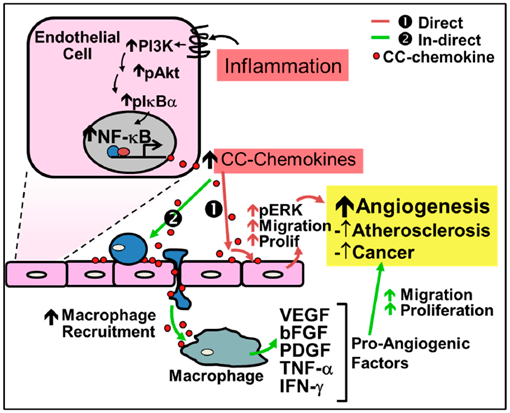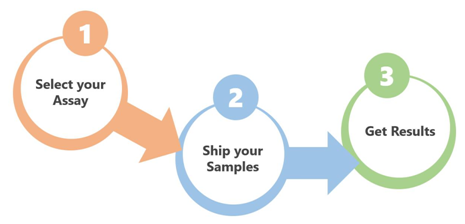Introduction
Chemokine is a cytokine or signaling protein secreted by a cell. Their name comes from their ability to induce directional movement of nearby responding cells. All identified chemokines have four cysteine residues in their conserved positions, and these residues are essential for forming their three-dimensional shape. Based on the difference in amino acid sequence between the two cysteine residues at the N-terminus, chemokines are divided into four main subfamilies: CXC, CC, CX3C, and XC. Among them, CC chemokine protein is different in that it has two adjacent cysteine near the amino terminus. The study found that in mammals, this subgroup has at least 27 different members, called CC chemokine ligands (CCL) -1 to -28, where CCL10 is the same as CCL9. It is known from the results of existing studies that CC chemokines can induce the migration of monocytes and other cell types such as NK cells and dendritic cells.
Mechanism and Function
CC chemokine receptors are membrane proteins that specifically bind and respond to the CC chemokine family. They are a large family of G protein-coupled receptors that transmembrane seven times. So far, ten members of the CC chemokine receptor subfamily have been discovered. When the released CC chemokine binds to the CC chemokine receptor on the surface of the target cell, a transmembrane transmission of the signal is initiated. Because the intracellular signal transduction of the CC chemokine receptor depends on the adjacent G protein, the receptor is in an inactive state when GDP binds to the receptor G protein. After binding to the chemokine ligand, the chemokine receptor can replace the G protein-bound GDP with a GTP molecule and dissociate the G protein subunit to complete the activation of the G protein. Activated G protein subunits cause subsequent activation of cell membrane-associated phospholipase C (PLC), which in turn cleaves phosphatidylinositol (4,5) -bisphosphate (PIP2) into inositol triphosphate (IP3) And diacylglycerol (DAG). Among them, IP3 induces a large influx of calcium, while DAG activates protein kinase C (PKC). These events promote subsequent cascades of related intracellular signaling, such as the PI3K, MAPK and ERK1/2 pathway. In addition, CC-chemokines can indirectly stimulate and involve the initial recruitment of macrophages to the site of inflammation, which secrete pro-angiogenic factors such as VEGF, bFGF, PDGF, TNF-α and IFN-γ that promote angiogenesis.
 Figure 1. Regulation of Multiple signaling pathways by CC-chemokines.
Figure 1. Regulation of Multiple signaling pathways by CC-chemokines.
Creative Proteomics can provide cytokine detection platform for scientific research. According to different purposes, our dedicated analysts will customize exclusive solutions for you. We aim to provide customers with high-quality and convenient services to help you accelerate the progress of your project.
Our cytokine detection service includes but is not limited to:
- Single cytokines analysis at qualitative and quantitative
- Multiple cytokines analysis at qualitative and quantitative
- Qualitative and quantitative detection of cytokines in various species
- Qualitative and quantitative detection of cytokine antibodies
Sample requirements
- Sample Types - Blood, serum, plasma, cell culture supernatant, cell lysate, cell culture medium, tissue homogenate, urine, tumor, etc.
- Sample Volume - It is optimal for at least 200µl of each sample. This volume allows for triplicate testing of each sample.
Our advantages:
- Multiple test methods can be chose based on samples and requirements.
- High-quality antibodies are used in the detection to ensure the specificity and accuracy of the test.
- Repeat test to ensure reproducibility and accuracy.
- Professional and efficient feedback results.
Technology platform:
We mainly provide the Luminex cytokine detection platform. Luminex uses fluorescently encoded microspheres with specific antibodies to different target molecules. The different microspheres can be combined freely to a certain extent so that up to 100 analytes can be tested multiple times simultaneously in a single experiment.
The Luminex cytokine assay platform has the following advantages:
- Multiple detection: simultaneous detection of 100 biological targets
- Short experiment time: 1-3 weeks
- High sensitivity: the lower limit of accurate quantification is as low as 0.1 pg/mL
- Save samples: only need a sample volume as low as 25 μL
- Time saving: the experiment process only takes 4 hours
For your different needs, we can also provide the following detection methods:
- Enzyme-linked immunosorbent assay (ELISA)
- Flow cytometry
Workflow

For more information on chemokines CC subfamily detection service or to require additional testing requirements, please contact us.
References:
- Anisyah Ridiandries et al. The Role of CC-Chemokines in the Regulation of Angiogenesis. Int. J. Mol. Sci. 2016. Doi:10. 0/ijms17111856.
- Ono SJ, Nakamura T, Miyazaki D. "Chemokines: roles in leukocyte development, trafficking, and effector function". The Journal of Allergy and Clinical Immunology. 2003.



